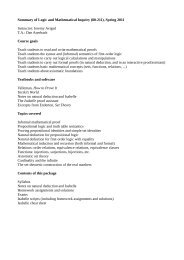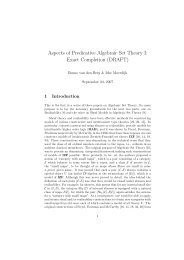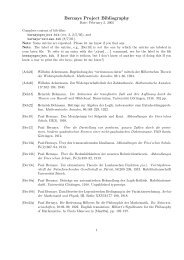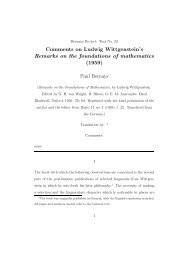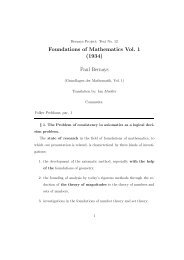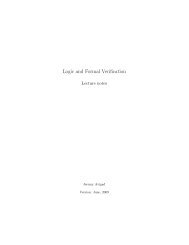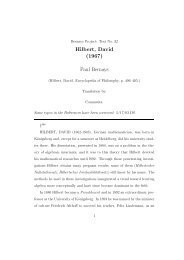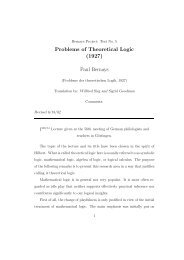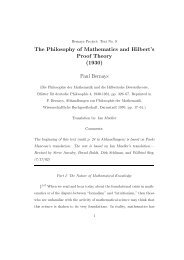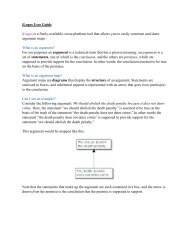Platonism in mathematics (1935) Paul Bernays - Phil Cmu
Platonism in mathematics (1935) Paul Bernays - Phil Cmu
Platonism in mathematics (1935) Paul Bernays - Phil Cmu
Create successful ePaper yourself
Turn your PDF publications into a flip-book with our unique Google optimized e-Paper software.
function has a maximum <strong>in</strong> a closed <strong>in</strong>terval. Very few th<strong>in</strong>gs <strong>in</strong> set theory<br />
rema<strong>in</strong> valid <strong>in</strong> <strong>in</strong>tuitionist <strong>mathematics</strong>.<br />
We would say, roughly, that <strong>in</strong>tuitionism is adapted to the theory of<br />
numbers; the semiplatonistic method, which makes use of the idea of the<br />
totality of <strong>in</strong>tegers but avoids quasi-comb<strong>in</strong>atorial concepts, is adapted to<br />
the arithmetic theory of functions, and the usual platonism is adequate for<br />
the geometric theory of the cont<strong>in</strong>uum.<br />
There is noth<strong>in</strong>g astonish<strong>in</strong>g about this situation, for it is a familiar proce-<br />
dure of the contemporary mathematician to restrict his assumptions <strong>in</strong> each<br />
doma<strong>in</strong> of the science to those which are essential. By this restriction, a the-<br />
ory ga<strong>in</strong>s methodological clarity, and it is <strong>in</strong> this direction that <strong>in</strong>tuitionism<br />
proves fruitful.<br />
But as you know, <strong>in</strong>tuitionism is not at all content with such a role; it<br />
opposes the usual <strong>mathematics</strong> and claims to represent the only true math-<br />
ematics.<br />
On the other hand, mathematicians generally are not at all ready to ex-<br />
change the well-tested and elegant methods of analysis for more complicated<br />
methods unless there is an overrid<strong>in</strong>g necessity for it.<br />
We must discuss the question more deeply. Let us try to portray more<br />
dist<strong>in</strong>ctly the assumptions and philosophic character of the <strong>in</strong>tuitionistic<br />
method.<br />
What Brouwer appeals to is evidence. He claims that the basic ideas<br />
of <strong>in</strong>tuitionism are given to us <strong>in</strong> an evident manner by pure <strong>in</strong>tuition. In<br />
rely<strong>in</strong>g on this, he reveals his partial agreement with Kant. But whereas for<br />
Kant there exists a pure <strong>in</strong>tuition with respect to space and time, Brouwer<br />
10



